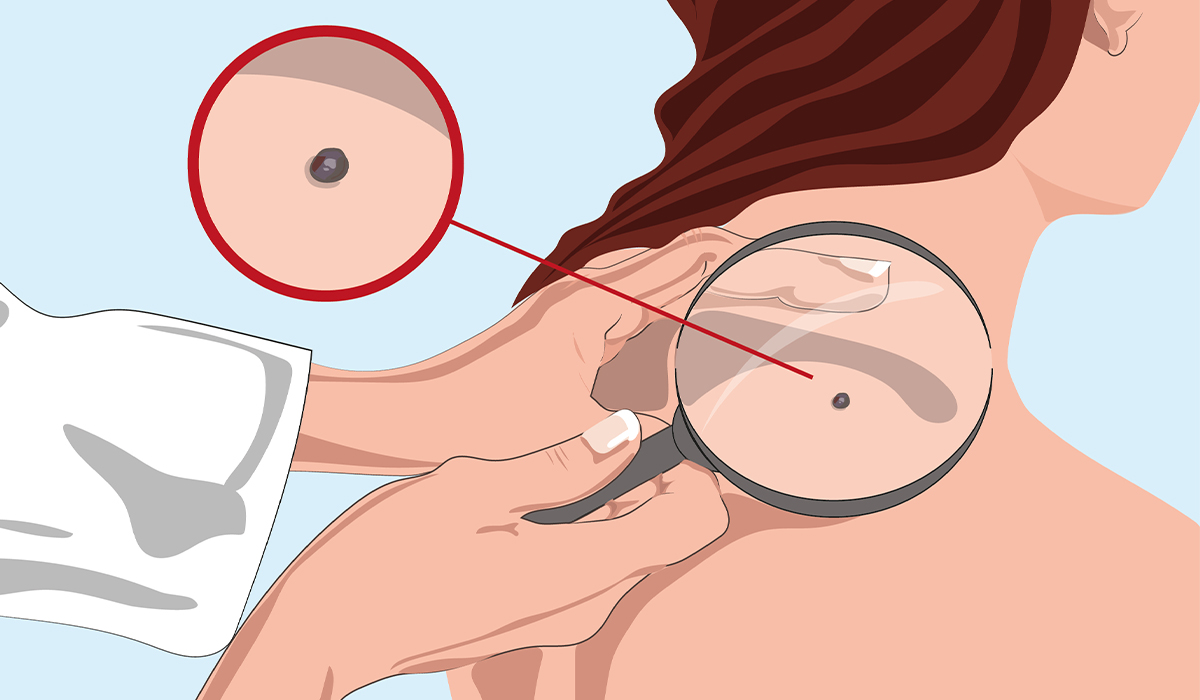Basal Cell Carcinoma (BCC) is a cancer that develops in basal skin cells. It usually appears on the skin exposed to sun ultraviolet rays and other sources, such as tanning beds. Basal cell carcinoma cancer growths usually resemble tiny bumps, pimples, lumps, and scabs. They rarely spread to other parts of the body.
Adequate treatments usually eliminate BCC, but there is a slight chance of developing this condition again. Early diagnoses improve the outlook and lower the risk of complications, such as severe and recurrent BCC, melanoma, and disfigurement.
Continue reading the article to learn how basal cell carcinoma affects your skin, the four main types of this condition, treatment options, and ways to prevent BCC from developing in your body.
Basal cell carcinoma is not only the most common form of skin cancer but also the most often observed type of all cancers. According to the Skin Cancer Foundation, 3.6 million Americans![]() are diagnosed with this condition each year. More than one of every three cancer diagnoses in the USA is basal cell carcinoma, making it the majority of all cases.
are diagnosed with this condition each year. More than one of every three cancer diagnoses in the USA is basal cell carcinoma, making it the majority of all cases.
Basal cells are responsible for replacing old skin cells by dividing and multiplying according to the information contained within their DNA. They are located in the outermost layer of the skin – the epidermis. When they produce new basal cells, the old ones are pushed toward the skin surface, where they die.
There are four main types of basal cell carcinoma. These include superficial spreading, sclerosing, nodular, and pigmented basal cell carcinoma![]() .
.
Superficial spreading basal cell carcinoma typically occurs on the upper back. Its characteristic symptoms include shallow plaques that resemble the color of the skin. They are very frail, so it is easy to damage them with fingernails. This often results in bleeding and pinpoint areas on the skin.
Superficial spreading basal cell carcinoma develops slowly and sometimes may appear on legs and arms.
Sclerosing basal cell carcinoma usually develops on the face. It poses a diagnostic challenge due to how it progresses. In the early stages, it causes lesions that resemble tiny white scars on the skin, which slowly get larger. It may take a long time before they are diagnosed as a type of basal cell carcinoma.
Nodular is the most common type of basal cell carcinoma. It can develop anywhere on the body, but the face is most commonly affected. Characteristic signs include round pimples with visible blood vessels around them.
Pigmented basal cell carcinoma occurs in people with dark skin, with Asians being most commonly affected. It causes nodules with pigment flecks around them.
Basal cell carcinoma occurs due to the change in the DNA of basal cells. The leading cause of mutation is ultraviolet (UV) rays from the sun or tanning beds. Regardless of the source, skin cells, including their DNA, may get damaged when the skin is hit by UV rays multiple times for a long time.
The DNA in skin cells contains information about the production process of these cells. If it is corrupted due to skin damage, cells can't grow properly, which results in cancerous growths instead of healthy skin.
However, the cell DNA does not get damaged instantly. Typically, skin cancer develops after many years of chronic exposure to ultraviolet rays. Other factors, including genetic diseases, family history of skin cancers, and immune-suppressing medications, may accelerate this process. See the paragraph below for more details about factors that make you more likely to develop basal cell carcinoma.

Many factors can increase the risk of basal cell carcinoma. Some of the most significant include:

Basal cell carcinoma typically affects body parts that are exposed to the sun. The most common places to develop this condition are face, arms, legs, nose, scalp, eyelids, and ears. In some cases, it may appear on the chest and back. Cancerous growths on your body may look different depending on the type, cause, and how long they are present on the skin. They usually include:
The main complication of basal cell carcinoma is recurrence. It may develop again despite successful treatment and even appear in the same place.
Untreated basal cell carcinoma may lead to severe and aggressive forms of skin cancer that cause disfigurement and may affect other body parts such as bones, muscles, nerves, and organs. Severe basal cell carcinoma is life-threatening and requires immediate medical attention.
Another complication of basal cell carcinoma is melanoma, the most dangerous type of skin cancer. Although BCC does not progress into melanoma normally, it has been proven that other types of skin cancer may develop during its course.
Basal cell carcinoma typically does not pose a diagnostic challenge![]() and can be assessed by a doctor during a physical examination, which involves visually inspecting an individual's skin. Cancerous growths on the skin, including bumps, discolorations, pimples, and shiny lumps, usually indicate BCC, so no other tests are needed.
and can be assessed by a doctor during a physical examination, which involves visually inspecting an individual's skin. Cancerous growths on the skin, including bumps, discolorations, pimples, and shiny lumps, usually indicate BCC, so no other tests are needed.
To confirm the initial assessment of BCC, your doctor may ask you questions about your symptoms, medical history, and skin changes. These questions may include the following:
If your doctor finds any skin changes that seem uncommon for basal cell carcinoma, they may order tests to find out if other health conditions cause the lumps. These tests may include:

Treatment strategies for basal cell carcinoma usually involve various types of surgeries that aim to remove cancerous growths completely. Your doctor will decide the form of treatment depending on the location of the lumps, their size, and the type of BCC. The most common treatment options are as follows:
The first step of the curettage and electrodesiccation procedure is scrapping the growth off with a surgical instrument called a curette. An electrocautery needle is then used to burn the cancer site. This type of surgery has a 95 percent success rate and is most effective against small growth. Another treatment strategy may be recommended against aggressive cases.
Mohs micrographic surgery is the most effective treatment for basal cell carcinoma, with a 99 percent success rate. Doctors usually recommend this procedure to remove large lumps and easily visible tumors.
During a procedure, a surgeon removes a thin layer of tissue that contains the growth step-by-step until no cancer remains. This surgical method also aims to leave as much healthy tissue as possible.
Surgical excision is when the tumor and a thin area of surrounding healthy skin are removed with a scalpel. This surgery is best advised to treat larger growths that have a high chance of affecting the surrounding skin. It has a very high success rate (95%).
In some cases, a patient may decide not to undergo a surgery procedure. This may be because of the doctor's recommendation due to the patient's other medical conditions or a personal preference. In these instances, the following treatment options may be recommended:
Basal cell carcinoma is usually not life-threatening. It expands slowly and rarely spreads to organs, nerves, or muscles![]() . Early diagnosis is crucial to prevent complications that may develop in its late stages.
. Early diagnosis is crucial to prevent complications that may develop in its late stages.
There is a chance that basal cell carcinoma will develop again after successful treatment, although it is low. If you notice skin changes that resemble your previous case of basal cell carcinoma, contact your healthcare provider as soon as possible.
Exposure to the sun is the primary factor that increases the risk of basal cell carcinoma, so applying sunscreen before going outside is the most effective countermeasure. Wearing sunglasses that block 100% of UVA and UVB rays is also worth considering to protect the eyes and the skin around them. However, no preventive measures can guarantee complete protection from skin cancer.
Basal cells in the epidermis constantly renew the skin, replacing old cells with new ones. Their function, however, can be affected by UV rays, which can damage their DNA and lead to mutations. These changes in basal cell structure cause the most common type of skin cancer – basal cell carcinoma (BCC).
In addition to prolonged sun exposure, risk factors of BCC include older age, family history of skin cancer, arsenic exposure, genetic diseases, specific physical features, immune-suppressing drugs, and radiation therapy. Complications include recurrence of BCC, potential disfigurement, and, in extreme cases, development of melanoma.
Diagnosis of basal cell carcinoma primarily involves visual inspection, including examining characteristic symptoms like scaly lesions or shiny lumps. Questions about symptoms, medical history, and risk factors assist in confirmation. Skin biopsy may be conducted to determine cancer type, while imaging tests detect potential spread to other parts of the body.
The prognosis is generally favorable, as BCC grows slowly and rarely spreads to other body parts. Early detection is critical to prevent complications, though recurrence is still possible.
Table of Contents

Squamous Cell Carcinoma is a type of skin cancer that comes from the squamous cells in the top layer of… read more »

Skin cancer is an ailment in which skin cells develop exceptionally quickly and out of control. It happens because of… read more »

Sun Poisoning is a more severe form of sunburn. Additional distressing symptoms may occur. Learn about the effects of sun… read more »

Albinism is a genetically determined disease. See how to spot the first signs of albinism. Learn about the risks associated… read more »

A polyp is an unexpected tissue growth that can occur in various places. Doctors usually find these growths on the… read more »

Sunburn is the result of the adverse and long-term effects of solar radiation on our skin. Are they dangerous? How… read more »

SPF is a measure of how well a sunscreen protects the skin from UVB rays, the type of ultraviolet radiation… read more »

Moles are common skin moles that can be harmless or indicative of disease. Read the article and increase your knowledge… read more »

Each day, approximately 9,500 people in the United States are diagnosed with one of the four forms of skin cancer.… read more »